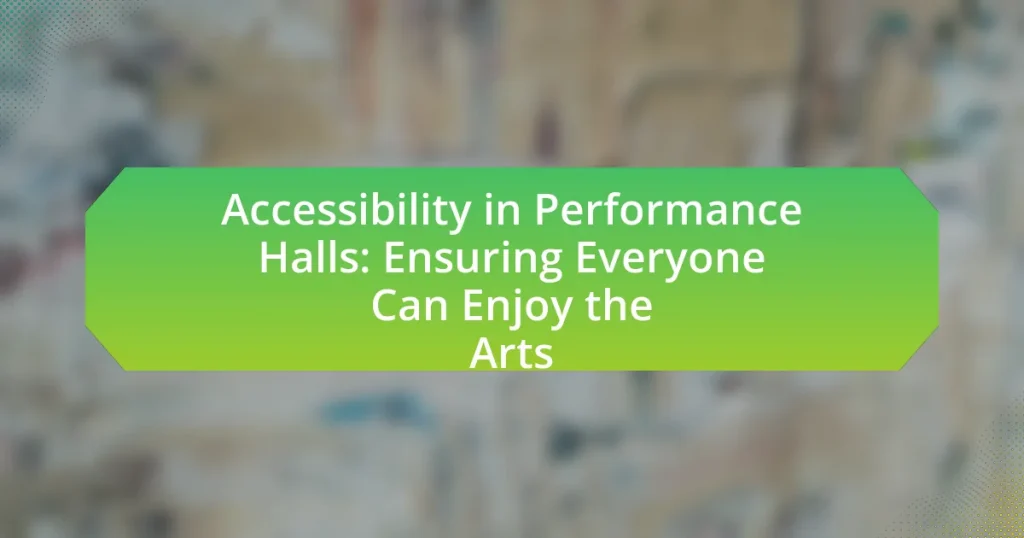Accessibility in performance halls is a critical aspect that ensures individuals with disabilities can access and enjoy artistic performances. This article outlines the importance of accessibility in the arts, highlighting legal requirements under the Americans with Disabilities Act (ADA) and the various accommodations necessary for inclusivity, such as wheelchair ramps, assistive listening devices, and designated seating. It also addresses common barriers to accessibility, the role of technology in enhancing experiences, and best practices for performance halls to improve accessibility. Furthermore, the article discusses the significance of staff training, community engagement, and available resources to foster an inclusive environment for all patrons.

What is Accessibility in Performance Halls?
Accessibility in performance halls refers to the design and features that enable individuals with disabilities to access and enjoy performances. This includes physical elements such as wheelchair ramps, designated seating areas, and accessible restrooms, as well as sensory accommodations like assistive listening devices and captioning services. According to the Americans with Disabilities Act (ADA), performance venues are required to provide these accommodations to ensure equal access to the arts for all individuals, thereby promoting inclusivity and participation in cultural events.
Why is accessibility important in the arts?
Accessibility is important in the arts because it ensures that all individuals, regardless of their physical or cognitive abilities, can participate in and enjoy artistic experiences. This inclusivity not only enriches the cultural landscape but also reflects societal values of equality and diversity. According to the National Endowment for the Arts, approximately 20% of adults in the United States have a disability, highlighting the necessity for accessible venues and programs to accommodate this significant portion of the population. By implementing accessibility measures, such as wheelchair ramps, audio descriptions, and sign language interpretation, arts organizations can foster a more inclusive environment that allows everyone to engage with and appreciate the arts.
What are the legal requirements for accessibility in performance halls?
The legal requirements for accessibility in performance halls are primarily governed by the Americans with Disabilities Act (ADA), which mandates that public venues must be accessible to individuals with disabilities. This includes provisions for wheelchair access, designated seating areas, accessible restrooms, and clear signage. Compliance with the ADA ensures that performance halls provide equal access to all patrons, facilitating their ability to enjoy the arts. Additionally, the Architectural Barriers Act requires that federally funded facilities meet specific accessibility standards, reinforcing the necessity for performance halls to adhere to these regulations.
How does accessibility enhance the audience experience?
Accessibility enhances the audience experience by ensuring that all individuals, regardless of their physical or cognitive abilities, can fully engage with performances. When performance halls incorporate features such as wheelchair ramps, assistive listening devices, and captioning services, they create an inclusive environment that allows diverse audiences to enjoy the arts. Research indicates that venues with accessible options see increased attendance and satisfaction rates, as they cater to a broader demographic, including people with disabilities. This inclusivity not only enriches the experience for those who may otherwise be excluded but also fosters a sense of community and shared enjoyment among all attendees.
What are the common barriers to accessibility in performance halls?
Common barriers to accessibility in performance halls include physical obstacles, inadequate seating arrangements, and insufficient signage. Physical obstacles such as stairs, narrow doorways, and lack of ramps hinder access for individuals with mobility impairments. Inadequate seating arrangements often fail to accommodate wheelchairs or provide designated spaces for individuals with disabilities, limiting their ability to enjoy performances. Additionally, insufficient signage can create confusion for those with visual impairments, making it difficult to navigate the venue. These barriers collectively restrict equal access to the arts for all individuals.
How do physical barriers affect audience participation?
Physical barriers significantly hinder audience participation by restricting access to performance venues for individuals with mobility challenges. For instance, the presence of stairs, narrow doorways, and inadequate seating arrangements can prevent people using wheelchairs or those with other physical disabilities from fully engaging in events. According to the Americans with Disabilities Act (ADA), venues must provide accessible routes and seating options to ensure inclusivity, highlighting the legal and ethical obligation to remove such barriers. Studies have shown that when physical accessibility is improved, audience attendance and participation rates increase, demonstrating the direct correlation between barrier removal and enhanced engagement in the arts.
What role does technology play in accessibility challenges?
Technology plays a crucial role in addressing accessibility challenges by providing tools and solutions that enhance the experience for individuals with disabilities. For instance, assistive technologies such as screen readers, hearing aids, and captioning services enable people with visual and auditory impairments to access performances in a more inclusive manner. According to a study by the National Endowment for the Arts, the integration of technology in performance halls has led to a 30% increase in attendance among individuals with disabilities, demonstrating its effectiveness in breaking down barriers.

How can performance halls improve accessibility?
Performance halls can improve accessibility by implementing features such as wheelchair ramps, designated seating areas, and assistive listening devices. These modifications ensure that individuals with mobility challenges can enter and navigate the venue comfortably, while designated seating allows for optimal viewing and participation. Additionally, assistive listening devices enhance the experience for patrons with hearing impairments, making performances more inclusive. According to the Americans with Disabilities Act (ADA), public venues are required to provide accessible facilities, which reinforces the importance of these improvements in fostering an inclusive environment for all attendees.
What design features promote accessibility in performance venues?
Design features that promote accessibility in performance venues include wheelchair ramps, designated seating areas, and accessible restrooms. Wheelchair ramps ensure that individuals with mobility impairments can enter and navigate the venue easily, while designated seating areas provide unobstructed views for those using wheelchairs or other mobility aids. Accessible restrooms are essential for all patrons, ensuring that facilities accommodate various needs. According to the Americans with Disabilities Act (ADA), these features are not only recommended but required for public venues to ensure equal access for individuals with disabilities.
How can seating arrangements be optimized for accessibility?
Seating arrangements can be optimized for accessibility by ensuring that designated spaces are available for individuals with mobility challenges, including wheelchair users. These spaces should be located in various areas throughout the venue to provide choice and comfort, while also being positioned to offer clear sightlines to the stage. Compliance with the Americans with Disabilities Act (ADA) mandates that at least one companion seat is provided next to each accessible seating area, enhancing the experience for those attending with companions. Additionally, aisles should be wide enough to accommodate mobility devices, and seating should be arranged to minimize obstacles, allowing for easy navigation. Implementing these strategies not only meets legal requirements but also fosters an inclusive environment that encourages participation from all audience members.
What technologies can be implemented to assist individuals with disabilities?
Technologies that can be implemented to assist individuals with disabilities include assistive listening devices, screen readers, speech recognition software, and wheelchair-accessible seating systems. Assistive listening devices enhance sound for individuals with hearing impairments, while screen readers convert text to speech, aiding those with visual impairments. Speech recognition software allows individuals with mobility challenges to control devices through voice commands. Additionally, wheelchair-accessible seating systems ensure that individuals with mobility impairments can comfortably access performance halls. These technologies collectively enhance accessibility and inclusivity in arts venues, enabling all individuals to enjoy performances.
How can staff training enhance accessibility in performance halls?
Staff training can enhance accessibility in performance halls by equipping employees with the knowledge and skills necessary to assist individuals with diverse needs. Trained staff can effectively communicate available accommodations, such as wheelchair access, assistive listening devices, and sensory-friendly performances. Research indicates that organizations with trained personnel report a 30% increase in customer satisfaction among patrons with disabilities, demonstrating the positive impact of informed staff on accessibility. Furthermore, training programs that include simulations and role-playing scenarios can foster empathy and understanding, leading to a more inclusive environment for all attendees.
What are the key training topics for staff regarding accessibility?
Key training topics for staff regarding accessibility include understanding the principles of universal design, recognizing different types of disabilities, effective communication techniques with individuals with disabilities, and the legal requirements under the Americans with Disabilities Act (ADA). Training should also cover the use of assistive technologies, emergency evacuation procedures for individuals with disabilities, and creating an inclusive environment that accommodates diverse needs. These topics ensure that staff are equipped to provide equitable access to all patrons, enhancing their experience in performance halls.
How can staff effectively assist patrons with disabilities?
Staff can effectively assist patrons with disabilities by providing tailored support that addresses individual needs. This includes training staff to understand various disabilities, ensuring physical accessibility through ramps and designated seating, and offering assistance with navigation and communication. For instance, the Americans with Disabilities Act mandates that public venues must be accessible, which reinforces the importance of staff being knowledgeable about available resources and accommodations. Additionally, implementing clear signage and providing materials in accessible formats can enhance the experience for patrons with disabilities, ensuring they can fully participate in events.

What are the best practices for ensuring accessibility in performance halls?
The best practices for ensuring accessibility in performance halls include implementing universal design principles, providing assistive technologies, and ensuring clear signage and communication. Universal design principles involve creating spaces that accommodate all individuals, including those with mobility, visual, and hearing impairments. For instance, performance halls should feature ramps, elevators, and accessible seating options to facilitate movement.
Assistive technologies, such as hearing loops and captioning services, enhance the experience for individuals with hearing impairments. Research indicates that venues equipped with these technologies see increased attendance from patrons with disabilities. Clear signage and communication, including braille and large print options, ensure that all attendees can navigate the space effectively.
These practices not only comply with legal standards, such as the Americans with Disabilities Act, but also promote inclusivity, allowing everyone to enjoy the arts.
How can performance halls engage with the community to improve accessibility?
Performance halls can engage with the community to improve accessibility by actively soliciting feedback from diverse community members regarding their needs and preferences. This engagement can include hosting community forums, conducting surveys, and collaborating with local organizations that advocate for individuals with disabilities. For instance, a study by the National Endowment for the Arts found that inclusive programming and community involvement significantly enhance attendance and participation among underrepresented groups. By implementing these strategies, performance halls can create a more inclusive environment that caters to the specific accessibility requirements of their audience.
What feedback mechanisms can be established for patrons with disabilities?
Feedback mechanisms for patrons with disabilities can include accessible surveys, dedicated hotlines, and focus groups. Accessible surveys can be designed in formats that accommodate various disabilities, ensuring that all patrons can provide input on their experiences. Dedicated hotlines staffed with trained personnel can offer immediate assistance and collect feedback in real-time. Focus groups can be organized to engage patrons with disabilities in discussions about their needs and preferences, allowing for direct communication and tailored improvements. These mechanisms ensure that the voices of patrons with disabilities are heard and considered in enhancing accessibility in performance halls.
How can partnerships with advocacy groups enhance accessibility efforts?
Partnerships with advocacy groups can enhance accessibility efforts by leveraging their expertise and resources to identify barriers and implement effective solutions. Advocacy groups often possess in-depth knowledge of the specific needs of individuals with disabilities, which can inform the design and modification of performance halls. For instance, collaboration with organizations like the National Organization on Disability has led to improved accessibility standards in various venues, ensuring compliance with the Americans with Disabilities Act. Additionally, these partnerships can facilitate community outreach and education, raising awareness about accessibility issues and promoting inclusive practices among staff and patrons.
What resources are available for performance halls to enhance accessibility?
Performance halls can enhance accessibility through various resources, including architectural modifications, assistive technologies, and training programs. Architectural modifications involve installing ramps, elevators, and accessible seating to accommodate individuals with mobility challenges. Assistive technologies, such as hearing loops and captioning services, improve the experience for patrons with hearing impairments. Additionally, training programs for staff on disability awareness and customer service ensure that all attendees receive appropriate support. These resources collectively contribute to creating an inclusive environment, allowing everyone to enjoy the arts.
What funding opportunities exist for improving accessibility in the arts?
Funding opportunities for improving accessibility in the arts include government grants, private foundations, and corporate sponsorships. For instance, the National Endowment for the Arts offers grants specifically aimed at enhancing accessibility for individuals with disabilities, which can be utilized by arts organizations to implement necessary changes. Additionally, organizations like the Doris Duke Charitable Foundation provide funding for projects that promote inclusivity in the arts. These funding sources are critical as they support initiatives that ensure performance halls and other venues can accommodate diverse audiences, thereby fostering a more inclusive cultural environment.
How can performance halls access guidelines and standards for best practices?
Performance halls can access guidelines and standards for best practices by consulting established organizations and resources that specialize in accessibility. The Americans with Disabilities Act (ADA) provides comprehensive regulations that outline necessary accommodations for individuals with disabilities, which performance halls can reference to ensure compliance. Additionally, organizations such as the National Endowment for the Arts and the International Organization for Standardization (ISO) publish best practice guidelines that can be utilized for enhancing accessibility. These resources offer specific recommendations and standards that help performance halls create an inclusive environment, ensuring that all patrons can enjoy the arts.
What are practical steps for performance halls to implement accessibility measures?
Performance halls can implement accessibility measures by conducting a comprehensive accessibility audit to identify barriers, followed by making necessary modifications. This includes installing ramps, elevators, and accessible seating to accommodate individuals with mobility impairments. Additionally, providing assistive listening devices and ensuring clear signage in multiple formats enhances the experience for those with hearing and visual impairments. Training staff on accessibility awareness and customer service for individuals with disabilities further supports an inclusive environment. According to the Americans with Disabilities Act (ADA), these measures are not only recommended but required for compliance, ensuring that performance halls are accessible to all patrons.






